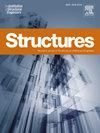Experimental study on the lateral impact resistance of PVA-ECC columns
IF 4.3
2区 工程技术
Q1 ENGINEERING, CIVIL
引用次数: 0
Abstract
The dynamic response of the Engineering Cementitious Composite (ECC) columns under multiple impacts was investigated via a drop-hammer impact test. The effect of four factors, including axial compression ratio, impact velocity, reinforcement ratio, and stirrup ratio on the dynamic response of columns were considered. The deformation mechanisms, cracking details (such as cracking pattern, the maximum width and the number of cracks), and the time-history curves of impact force and displacement were evaluated and contrasted with those of the reinforced concrete (RC) columns. Furthermore, the degree of internal damage and bending deformation of ECC columns under multiple impacts were investigated. The results show that ECC column could absorb nearly twice as much energy as the RC column while maintaining structural integrity, and it could bear more impacts under the same reinforcement layout and axial compression conditions. The damage factor D in the deformation zone of ECC column was about 1/127 of RC column under the same impact energy of 7816 J, this indicated that the ECC column has a slight tendency towards damage and bending deformation, while the RC column had undergone brittle shear failure. Moreover, when the impact energy was 7816 J and the axial compression ratio increased from 0.13 to 0.4, the peak impact force of the ECC column increased, while the maximum mid-span displacement and residual mid-span displacement decreased. With the increase of reinforcements, the number of fine cracks increased, but the maximum crack width, peak impact force, and maximum mid span displacement decreased. The experimental results presented herein provide benchmark data for the practical engineering applications of ECC columns subjected to horizontal impact forces.
PVA-ECC柱抗侧冲性能试验研究
通过落锤冲击试验,研究了工程胶凝复合材料(ECC)柱在多次冲击下的动力响应。考虑轴压比、冲击速度、配筋率、配筋率等4个因素对柱动力响应的影响。对其变形机理、裂缝形态、裂缝最大宽度和裂缝数量等裂缝细节、冲击力和位移时程曲线进行了评价,并与钢筋混凝土柱进行了对比。此外,还研究了ECC柱在多重冲击下的内部损伤程度和弯曲变形。结果表明:在保持结构完整性的情况下,ECC柱吸收的能量几乎是RC柱的两倍,在相同的配筋布置和轴压条件下,ECC柱能够承受更大的冲击。在相同冲击能为7816 J的情况下,ECC柱变形区损伤因子D约为RC柱的1/127,说明ECC柱有轻微的损伤和弯曲变形倾向,而RC柱发生了脆性剪切破坏。当冲击能为7816 J,轴压比由0.13增加到0.4时,ECC柱的峰值冲击力增大,最大跨中位移和剩余跨中位移减小。随着加筋量的增加,细裂纹数量增加,最大裂缝宽度、峰值冲击力和最大跨中位移减小;本文的试验结果为ECC柱在水平冲击作用下的实际工程应用提供了基准数据。
本文章由计算机程序翻译,如有差异,请以英文原文为准。
求助全文
约1分钟内获得全文
求助全文
来源期刊

Structures
Engineering-Architecture
CiteScore
5.70
自引率
17.10%
发文量
1187
期刊介绍:
Structures aims to publish internationally-leading research across the full breadth of structural engineering. Papers for Structures are particularly welcome in which high-quality research will benefit from wide readership of academics and practitioners such that not only high citation rates but also tangible industrial-related pathways to impact are achieved.
 求助内容:
求助内容: 应助结果提醒方式:
应助结果提醒方式:


